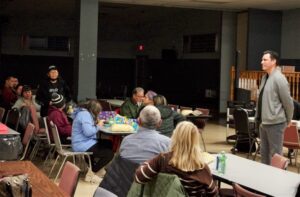Fort William First Nation screens Bones of Crows film

By Rick Garrick
FORT WILLIAM — Memories and emotions about Indian Residential Schools were raised during the Bones of Crows film screening on April 29 at the Fort William First Nation Community Centre. The Bones of Crows film features a multi-generational story of resilience told through the eyes of a Cree matriarch who was removed from their family and forced to attend Indian Residential School.
“It’s very emotional and it brought back sayings and words that were spoken to me when I was little from my granny,” says Belinda Robertson, an Indian Residential School Survivor and Fort William citizen. “My mom was [a Residential School Survivor] and all of her sisters, so it’s in our family.”
Robertson says one of her memories that was brought back was when her hair was cut at Indian Residential School.
“They said the reason they were doing it was because I might have lice,” Robertson says. “It’s just painful things like that are coming back. I repressed a lot and now I’m talking a lot more about it but it takes me a while to speak because I was always told, ‘Don’t talk.’”
Liz Esquega, community coordinator at Fort William who is involved with Fort William’s St. Joseph’s Residential School project, says the film featured the portrayal of an Indian Residential School experience that is similar to that of many Residential School Survivors.
“There were a lot of scenes in the movie that were very triggering and I’m sure it triggered a lot of the Residential School Survivors in the audience,” Esquega says. “I think there was one sitting right next to me, at the end of the movie she was in tears and had taken probably about half an hour or so just to recover.”
Margaret Bannon, a Fort William citizen, says the film shows how Indian Residential Schools affected generations of First Nations people.
“There’s the Survivors, their children and grandchildren, and the pain gets carried on,” Bannon says. “I’m a mental health councillor working with Residential School Survivors and their descendants, it’s so important to look after yourself. Watching the movie affects us emotionally, triggers our own history, and triggers pain. Being able to look after ourself is so important not only for ourselves but our children and our future generations and being able to help the people around us.”
Doug Little, an Indigenous resident of Fort William, says the film “hits home.”
“I know Survivors and I know a lot of people in the community,” Little says. “We all need to help each other and heal from it — this is good that they’re getting this [film] out to help some more people come forth and be able to heal.”
Elder Ma-Nee Chacaby, author of A Two-Spirit Journey: The Autobiography of a Lesbian Ojibwa-Cree Elder, says the film brought up a lot of memories from the past.
“I didn’t go to Residential School but my brother did and my sister did,” says Chacaby, who spoke during the sharing session after the film. “I wanted to share some stuff that brought the memories back about my sister, and that it really happened. People are just starting to understand what happened to (First Nations people), we should have had all these things written down a long time ago.”
Jerome Turner, national tour director and location manager for Bones of Crows, says it was important for Marie Clements, writer, director and producer of Bones of Crows, to have the film screened in smaller communities across the country before it was released in theatres in June.
“A lot of people really are moved by it and impacted by it profoundly just based on the intensity of some of the scenes and the accuracy of the truth that it shares,” Turner says.


